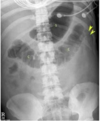Lecture 3 - Pancreas Disorders Flashcards
What are 3 of the most common neoplasias associated with MEN-2A?
- Parathyroid hyperplasia –> hypercalcemia
- Medullary thyroid carcinoma –> elevated calcitonin = low Ca2+
- Pheochromocytoma –> elevated catecholamines

Autoimmune pancreatitis is associated with high levels of?
Hypergammaglobulinemia (IgG4)
When should Rapid-bolus IV contrast-enhanced CT be avoided in Acute Pancreatitis?
When serum Cr > 1.5 mg/dL
Which drug can improve pain in chronic pancreatitis and low pain medicaton requirement?
Pregabalin
What are some of the complications associated with Severe Acute Pancreatitis?
- Necrotizing pancreatitis
- Acute respiratory distress syndrome (ARDS)
- Multisystem organ failure
- Intravascular volume depletion
- Ileus
Which imaging modality for Chronic Pancreatitis may show calcification not seen on plain film?
CT
Treatment for Chronic Pancreatitis requires abstaining from what?
Aimed at controlling?
- Abstain from alcohol use
- Aimed at controlling pain and malabsorption
How does Acute Pancreatitis lead to Hypocalcemia?
- Saponification
- Cations (Ca2+) interact w/ FFA’s released by actions of activated lipases on TAG’s in fat cells —> Hypocalcemia
In patients with Chronic Pancreatitis w/ suspected pancreatic steatorrhea (malabsorption/insufficiency), which tests are useful for evaluation?
- Fecal elastase-1
- Small-bowel biopsy
Which % of pancreatic necrosis is associated with 2, 4, or 6 additional points added to the CT grade points for the severity index of acute pancreatitis?
- <30% = 2 points
- 30-50% = 4 points
- >50% = 6 points

What will levels of Fecal-Elastase be like in pancreatic exocrine insufficiency?
Low (<100 mcg/gram stool)

Upon PE of someone with Acute Pancreatits what are some of the common findings you can expect to see?
- Low-grade fever, tachycardia, hypotension (even shock)
- Erythematous skin nodules due to subcutaneous fat necrosis
- Basilar rales and pleural effusion (often on the left - fluid shifts) –> (edema-3rd spacing)
- Cullen’s sign (periumbilical) or (Grey) Turner’s sign (flanks)
Which imaging modalities should be considered in pts with recurrent pancreatitis, especially after repeated attacks of idiopathic acute pancreatitis?
- Endoscopic retrograde cholangiopancreatography (ERCP)
- Magnetic resonance cholangiopancreatography (MRCP)
What are 5 of the risk factors for high levels of fluid sequestration (3rd spacing/edema) seen in Acute Pancreatitis?
- Younger age
- Alcohol etiology
- Higher hematocrit value
- Higher serum glucose
- Systemic Inflammatory Response Syndrome in the first 48 hours of admission
What are 5 risk factors for Acute Pancreatitis?
- Smoking
- High dietary glycemic load
- Abdominal adiposity
- Increasing age
- Obesity
What is the mnemonic and values for the Ranson Criteria used 48 hours after admission for Acute Pancreatitis?
C-HOBBS
Calcium <8
Hematocrit drop >10%
Oxygen (PaO2) <60mmHg
Base deficit >4
BUN increase >5
Sequestration of fluid >6

What is Trousseau’s sign of hypocalcemia vs. Trousseau’s sign of malignancy?
- Of Malignancy = repeated attacks of multiple venous thrombosis (migratory thrombophlebitis) –> pancreatic cancer
- Hypocalcemia = spasm of muscles of hand + forearm w/ flexion at wrist after putting BP cuff on patient

What are some examples of trauma which can cause Acute Pancreatitis?
- Blunt abdominal trauma
- Surgery
- Peritoneal dialysis
Elevated amylase is not the preferred marker for Acute Pancreatitis because it can also be elevated in which 6 conditions?
- High intestinal obstruction
- Gastroenteritis
- Mumps (not involving pancreas - salivary amylase)
- Ectopic pregnancy
- Administration of opioids
- Post-abdominal surgery
What are the 2 most common causes of Acute Pancreatitis in the US?
- Cholelithiasis (gallstones)
- Alcohol
What are some of the common complications associated with Chronic Pancreatitis?
Which specific type of diabetes?
- Chronic abdominal pain
- Gastroparesis
- Malabsorption/Maldigestion/Malnutrition/Steatorrhea
- Impaired glucose tolerance (Brittle diabetes mellitus)
- Nondiabetic retinopathy
- Bile duct stricture, osteoporosis, and peptic ulcer
- Pancreatic cancer
When is Rapid-bolus IV Contrast-Enhanced CT used for Acute Pancreatitis?
Which steps need to be taken to perform the test?
Identifies?
- Following aggressive volume resuscitation
- Particularly useful after 3 days of severe acute pancreatits
- Identifies areas and degree of pancreatic necrosis
What “sign” is this and what pathology is it associated with?

- “Sentinel Loop”
- Acute pancreatitis
Large elevations (>3x normal) of amylase virtually assure the diagnosis of Acute Pancreatitis as long as which other pathologies have been excluded?
- Salivary gland disease
- Intestinal perforation/infarction




















